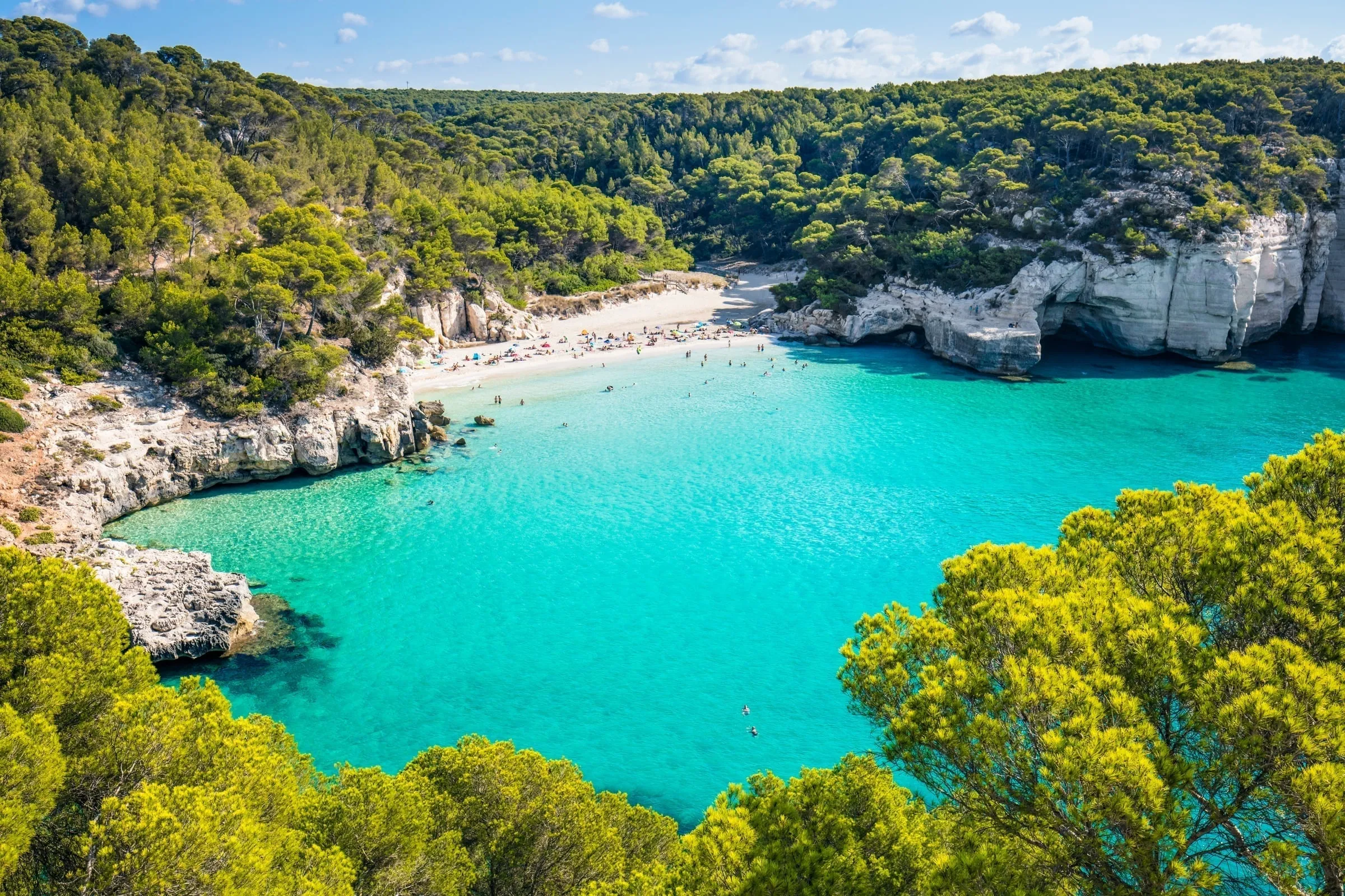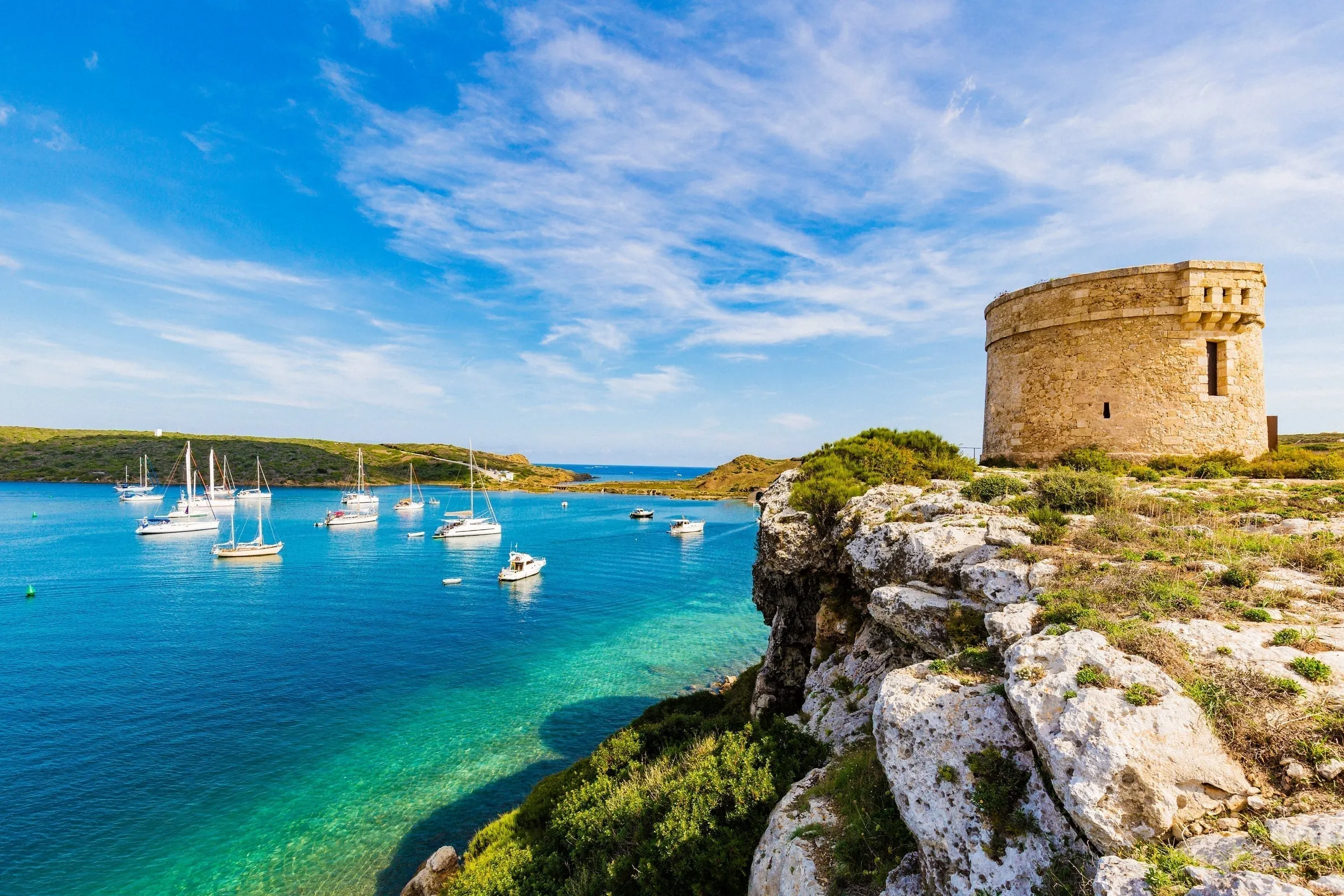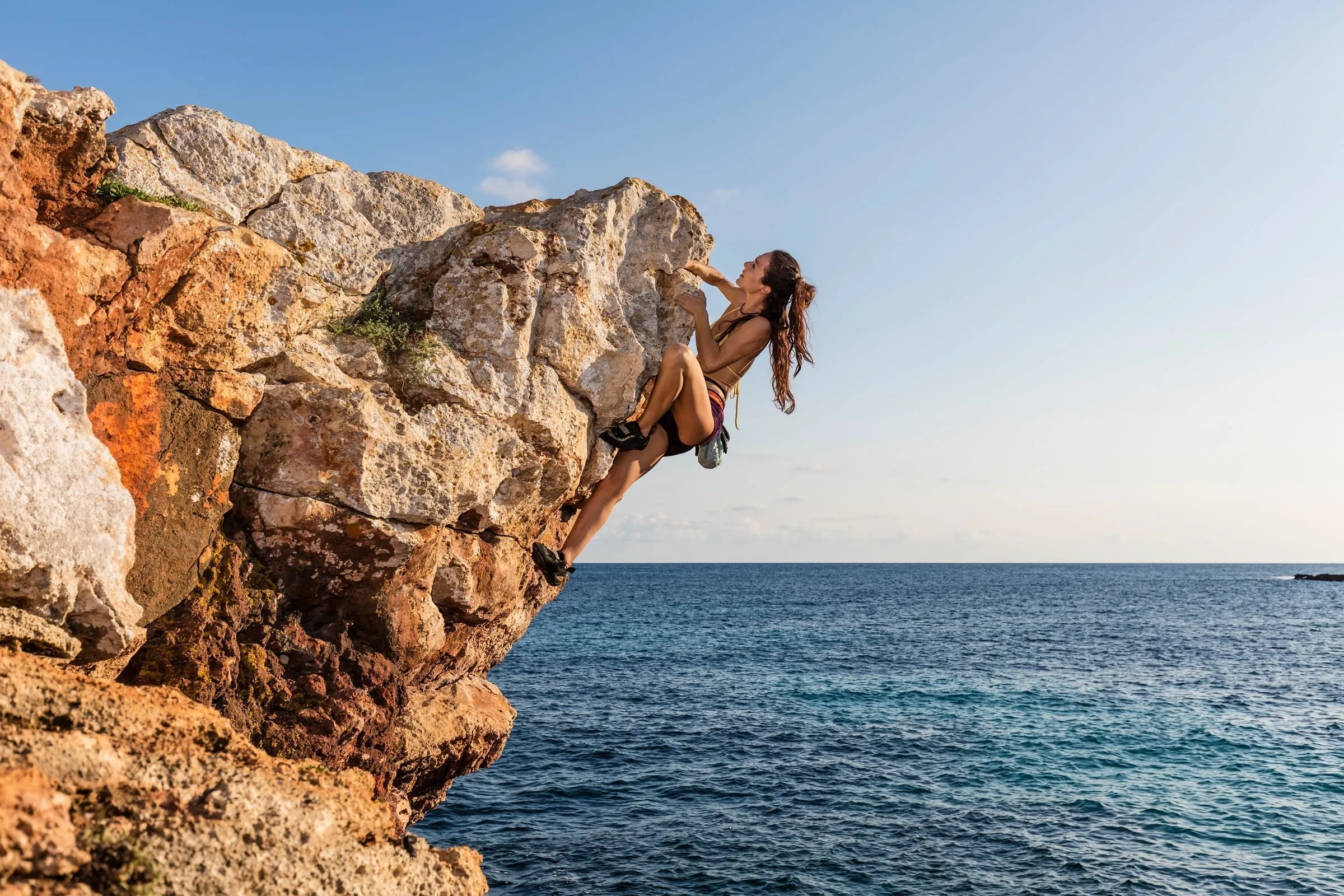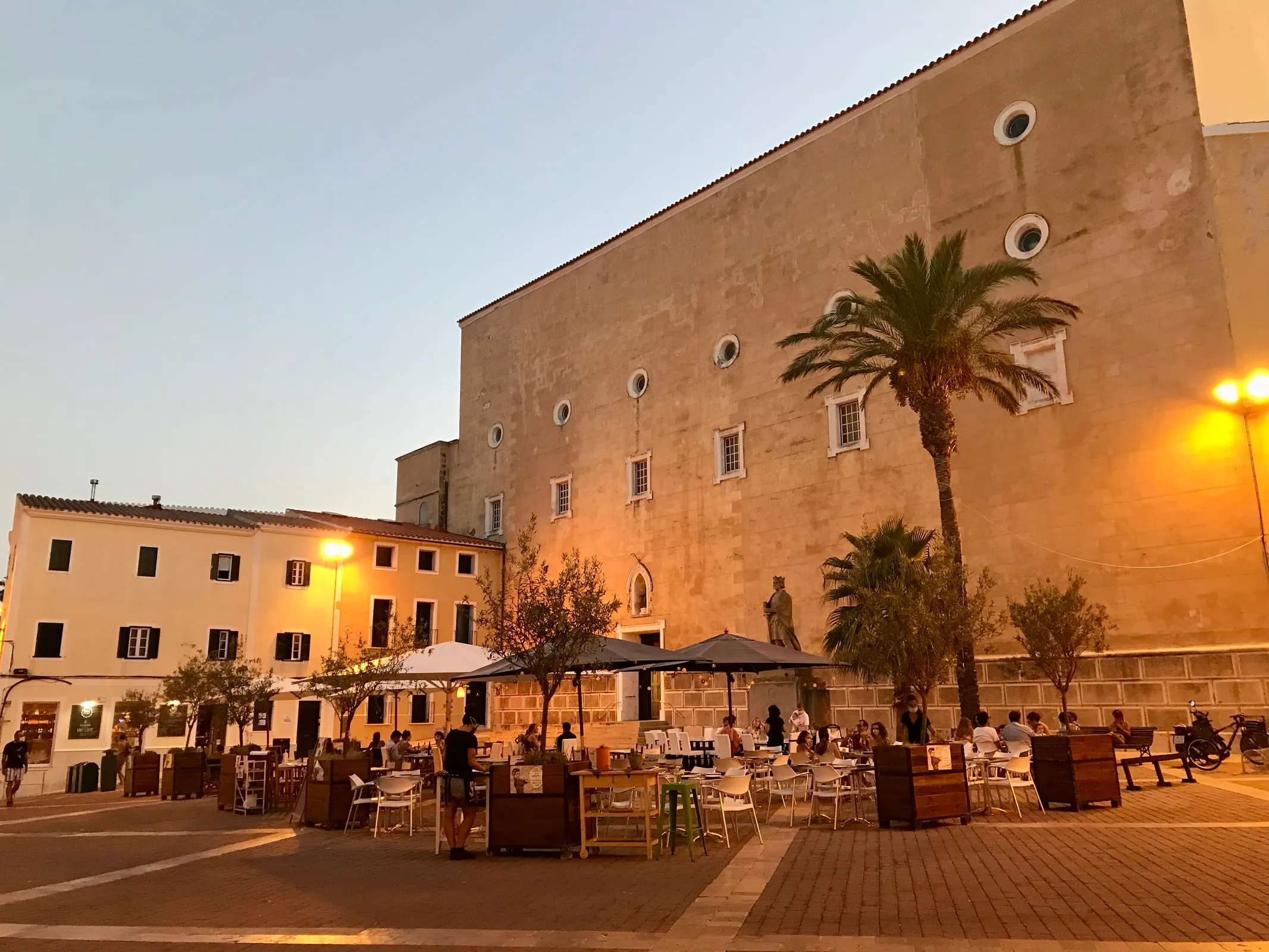The Military Path That Became a Hiker’s Paradise
At dawn on a September morning, I’m standing at Cala Galdana watching the sun paint the Mediterranean gold while adjusting my pack for day three of the Camí de Cavalls. Yesterday I walked past Cala Macarella’s impossibly turquoise water, scrambled across limestone headlands where Audouin’s gulls nest, and wild-camped beneath stars so bright they cast shadows. In three days of walking, I’ve encountered perhaps 20 other hikers but hundreds of pristine coves.
This is the magic of Menorca’s GR223 a 185-kilometer coastal path that encircles the entire island, connecting military history with natural beauty in ways that make every step a discovery. Unlike Mallorca’s crowded Serra de Tramuntana, the Camí de Cavalls remains genuinely wild, genuinely challenging, and genuinely rewarding for those willing to carry everything they need and expect nothing but spectacular scenery.
I’ve walked this path in sections over 12 years, watching it evolve from a local secret to an international hiking destination while somehow maintaining its essential character: ancient, authentic, and absolutely committed to showing you the Mediterranean as it existed centuries ago.
From Horsemen to Hikers: The Path’s Military Origins
The Camí de Cavalls (“Path of Horses”) was created in the 14th century as a military patrol route, allowing mounted soldiers to circle the island and defend against pirates and invaders. Every 3-4 kilometers, watchtowers provided lookout points and emergency shelter. Many of these towers still stand, creating natural waypoints for modern hikers.
The Historical Reality This wasn’t a scenic walking route – it was strategic infrastructure. The path was built wide enough for horses carrying armed soldiers, positioned to provide maximum visibility of potential landing spots, and maintained because island survival depended on early warning systems.
Modern Adaptation The GR223 designation came in 1996, but the path itself remained largely unchanged. Unlike created hiking trails, you’re following routes that served essential military purposes for 600 years. The authenticity is remarkable – and so is the rugged character that military efficiency demanded.

Cala Mitjana from above: This is what you’ll discover on stage 12 of the Camí de Cavalls – pristine beaches accessible only on foot, just as they’ve existed for centuries.
The Trail That Encircles Paradise: Understanding the GR223
The Complete Circuit: 185km of Coastal Perfection
The Camí de Cavalls is unique among European long-distance trails because it forms a complete circuit. Start anywhere, walk in either direction, and eventually return to your starting point having seen every type of Mediterranean coastal landscape Menorca contains.
Clockwise vs. Counterclockwise Most hikers walk clockwise (following the official stage numbers), but experienced locals often prefer counterclockwise for better light on the dramatic northern cliffs. The prevailing winds also favor counterclockwise walking during certain seasons.
Stage Structure 20 official stages ranging from 6km to 13km, designed to connect the island’s main towns and accommodation options. But the beauty of a circular route is that you can start and end wherever suits your logistics.
Natural Divisions The path naturally divides into four distinct sections: the dramatic northern cliffs, the wilderness eastern coast, the postcard-perfect southern coves, and the varied western shoreline. Each section offers completely different hiking experiences.
What Makes This Trail Special
Coastal Walking Unlike most Mediterranean coastal paths that occasionally glimpse the sea, the Camí de Cavalls rarely strays more than 500 meters from the water. You’re constantly engaged with marine landscapes, changing with wind, tide, and weather.
Beach Access The trail provides walking access to over 75 beaches and coves, many completely inaccessible by car. These aren’t tourist beaches – they’re wild Mediterranean coastline as it existed before development.
Archaeological Integration Roman ruins, Talayotic settlements, medieval watchtowers, and British colonial structures are woven into the hiking experience. You’re not just walking – you’re traveling through 3,000 years of Mediterranean history.
Wildlife Corridors The coastal zone protects migration routes, nesting areas, and feeding grounds for dozens of bird species, plus marine life that depends on undisturbed shorelines.

The Camí de Cavalls on Menorca’s northern coast: where military patrol routes become hiking paradise, offering views that have guided seafarers for centuries.
Stage-by-Stage Guide: The Complete 185km Journey
The Northern Drama: Stages 1-6 (Mahón to Fornells)
Stage 1: Mahón to Es Grau (8km, 2.5 hours) Starting from Menorca’s capital, this gentle introduction follows the impressive Port de Mahón before heading to the protected wetlands of S’Albufera des Grau. The contrast between urban sophistication and wild nature sets the tone for the entire journey.
Highlights Europe’s second-largest natural harbor, birdwatching opportunities, and your first taste of undeveloped Menorcan coastline.
Stage 2: Es Grau to Favàritx (7.5km, 2.5 hours) This stage introduces the northern coast’s dramatic character – dark slate cliffs, exposed headlands, and the iconic Far de Favàritx lighthouse standing against often turbulent seas.
Challenge Exposed walking with little shelter. The landscape is moonlike and magnificent, but weather can change quickly.
Stage 3: Favàritx to Arenal d’en Castell (10km, 3.5 hours) The most challenging northern stage, following cliff edges and crossing several deep barrancs (ravines). The lighthouse-to-lighthouse walking provides constant navigation reference points.
Reality Check This is serious coastal hiking. Good boots and confidence with rough terrain are essential. The rewards are spectacular but earned through effort.
The Wilderness East: Stages 7-10 (The Remote Quarter)
Stages 7-9: Arenal d’en Castell to Cala en Porter (Combined 25km) The island’s most remote section, where you might walk for hours without seeing another person. Multiple pristine coves provide swimming opportunities, but carry everything you need.
Wild Camping Potential This section offers Menorca’s best opportunities for wild camping (though officially prohibited). Isolated coves and hidden valleys provide sheltered spots for those willing to camp discreetly.
Water Strategy Limited reliable water sources. Carry 3+ liters per person and know the locations of seasonal springs marked on detailed hiking maps.
The Postcard South: Stages 11-15 (The Tourist Magnet)
Stage 12: Son Bou to Cala Galdana (8.5km, 3 hours) Perhaps the most photographed section, passing Cala Macarella and Cala Macarelleta beaches so beautiful they’ve become synonymous with Menorca tourism.
Crowd Management These beaches attract day visitors, so early morning or late afternoon walking provides better solitude. The coves are worth the crowds, but time your arrival strategically.
Stage 13: Cala Galdana to Ciutadella (13km, 4.5 hours) The longest stage, but it concludes at Menorca’s former capital – a perfect reward for completing the southern circuit’s most demanding section.
The Varied West: Stages 16-20 (The Wild Card)
Stages 16-20: The Western Circuit (45km total) More diverse than other sections, mixing sandy beaches, rocky coves, and the unique landscape around Cala Tirant and Fornells Bay. This section shows Menorca’s different personalities within short distances.
Local Secrets The western stages pass several traditional fishing settlements and working farms, providing glimpses of authentic Menorcan life that tourism hasn’t completely transformed.
Camí de Cavalls Complete Circuit
challenging- 185km of pristine coastal walking
- 75+ beaches and coves accessible only on foot
- Ancient watchtowers and archaeological sites
- Complete circuit of UNESCO Biosphere Reserve
Southern Coves Day Hike
moderate- Access to Cala Macarella and Macarelleta
- Spectacular limestone cliff formations
- Turquoise waters and white sand beaches
- Ancient Talayotic settlement ruins
The Practical Reality: Planning Your Camí Experience
Accommodation Strategy: Hotels, Hostels, and Wild Camping
Official Accommodations The 20-stage structure connects towns and villages with established lodging, from rural guesthouses (€45-75/night) to resort hotels (€120-280/night).
Budget Options Youth hostels in major towns, rural hostels, and some working farms offer accommodation for €25-40/night. Book ahead – options are limited.
Wild Camping Reality Officially prohibited but widely practiced by long-distance hikers. The key is discretion: arrive late, leave early, camp out of sight, and leave no trace. Many isolated coves provide perfect wild camping spots.
Camping Strategies
- Eastern coast stages 7-10 offer best wild camping opportunities
- Northern cliffs provide shelter from prevailing winds
- Southern beaches are too visible and crowded for camping
- Always carry extra water – springs are unreliable
Navigation and Trail Conditions
Waymarking Generally excellent with white and red GR223 paint marks, but some sections fade due to salt spray and weather exposure. GPS backup recommended for challenging sections.
Trail Surface Varies dramatically – ancient cobbled paths, modern gravel tracks, rocky coastal scrambles, and sandy beach walking. One pair of boots won’t optimize for everything, but sturdy hiking boots work for 90% of terrain.
Hazards Cliff edges (especially northern sections), flash flood potential in barrancs, occasional hunting activity (September-February), and marine hazards during storms.
Emergency Procedures 112 provides island-wide emergency coverage. Guardia Civil and local fire brigades respond to hiking emergencies. Limited mobile coverage in eastern sections.
Water, Food, and Resupply
Water Sources Municipal fountains in towns, seasonal springs marked on hiking maps, and occasional rural wells. Carry purification tablets for uncertain sources. In summer, carry 4+ liters for longer stages.
Food Strategy Resupply opportunities every 2-3 stages in towns and villages. Carry 1-2 days’ food as backup. Local supermarkets stock hiking-appropriate foods but selection is limited.
Local Specialties Try sobrasada (spreadable sausage), mahón cheese aged in natural caves, and gin de Mahón a local specialty that reflects British colonial influence.

Psicobloc in Menorca: the island’s limestone cliffs and clear water make it a world-class destination for deep water soloing – rock climbing with the sea as your safety net.
Beyond Walking: Menorca’s Adventure Playground
Psicobloc: The Sport Menorca Invented
Menorca is considered the birthplace of psicobloc (deep water soloing) – rock climbing over water without ropes, using the sea as your crash pad. The island’s limestone cliffs and crystal-clear water create perfect conditions for this thrilling sport.
Best Locations Cala Rafalet, Es Canonge, and Punta Prima offer routes from beginner to expert level. The season runs April-October when water temperatures make falls more comfortable.
Safety Considerations Understand tides, wave conditions, and water depth before climbing. Even experienced climbers should go with local guides initially – hidden rocks and current patterns aren’t obvious to visitors.
Equipment Climbing shoes, chalk bag, and swimming ability are essential. Many visitors rent equipment in Ciutadella or Mahón.
Sea Kayaking: Exploring Hidden Coves
The Camí de Cavalls reveals beaches from land, but sea kayaking accesses sea caves, hidden coves, and offshore perspectives impossible from the hiking trail.
Popular Routes Fornells Bay for beginners, Cala Galdana to Cala Macarella for intermediate paddlers, and the wild eastern coast for experts.
Wildlife Opportunities Dolphins occasionally appear in deeper waters, while coastal caves shelter bats and seabirds. The clear water provides excellent conditions for observing marine life.
Archaeological Treasures: 3,000 Years of History
The Camí de Cavalls connects dozens of archaeological sites representing Mediterranean cultures from Bronze Age to modern times.
Talayotic Culture Torre d’en Galmés and Naveta d’es Tudons showcase sophisticated Bronze Age civilizations unique to Menorca and Mallorca.
Roman Influence Sanitja and other coastal sites reveal Roman trading posts and villa foundations.
British Colonial Period Georgian architecture in Mahón and defensive fortifications reflect 18th-century British rule.

Mahón’s old town: Georgian colonial architecture meets Mediterranean plaza culture, creating the unique atmosphere that makes Menorca’s capital special.
Seasonal Strategies: When to Walk the Camí
Spring (March-May): The Awakening Island
Advantages Wildflowers bloom across the island, temperatures are perfect for long-distance walking (15-22°C), and tourist crowds haven’t arrived. Water sources are most reliable after winter rains.
Challenges Weather can be unpredictable with occasional storms. Some accommodations and restaurants remain closed from winter. Sea temperatures are still cool for swimming (16-18°C).
Best For Serious hikers who prioritize trail conditions over swimming opportunities, nature photographers interested in wildflower displays, and budget travelers avoiding peak season prices.
Summer (June-August): The Busy Season
Advantages: Warmest weather, longest days, all facilities open, best conditions for combining hiking with swimming and water sports.
Challenges: Crowds at popular beaches, accommodation prices peak, afternoon heat can make hiking dangerous (30-35°C), and limited wild camping opportunities due to increased patrols.
Strategy Early morning starts (5:30am), siesta during midday heat, afternoon swimming, and evening walking when temperatures drop.
Autumn (September-November): The Golden Season
Advantages: Ideal temperatures (20-26°C), fewer crowds but facilities still open, sea remains warm from summer heating (22-24°C), and stable weather patterns.
Challenges: Hunting season (September-February) requires awareness of hunting areas, some seasonal accommodations close in November, and daylight hours decrease.
Best For: Most hikers consider this the optimal Camí season – combining good weather, manageable crowds, and excellent trail conditions.
Winter (December-February): The Local Experience
Advantages: Complete solitude on most trail sections, authentic local atmosphere, dramatically lower accommodation prices, and unique storm-watching opportunities.
Challenges: Many accommodations and restaurants close, weather is unpredictable with potential storms, daylight limited to 9-10 hours, and sea conditions can be rough.
For Experienced Hikers Only Winter Camí hiking requires self-sufficiency, flexible planning, and comfort with challenging conditions.
When to Visit
Jan
Wild and windy
Feb
Challenging conditions
Mar
Trail awakening
Apr
Perfect hiking weather
★ BestMay
Ideal conditions
★ BestJun
Warming up
Jul
Early starts essential
Aug
Hot but manageable
Sep
Golden season begins
★ BestOct
Perfect balance
★ BestNov
Peaceful hiking
Dec
Local island only
Environmental Ethics: Hiking in a UNESCO Biosphere Reserve
Understanding Menorca’s Protected Status
Menorca received UNESCO Biosphere Reserve designation in 1993, recognizing the island’s success in balancing human development with environmental protection. The Camí de Cavalls walks through the heart of this protected landscape.
What This Means Every step of your hike occurs within managed ecosystems designed to preserve Mediterranean island biodiversity while allowing sustainable human use.
Your Responsibilities Follow Leave No Trace principles rigorously, stay on marked trails, respect wildlife and vegetation, and understand that you’re visiting someone else’s carefully protected home.
Wildlife Encounters and Protection
Marine Life Menorca’s waters support important populations of dolphins, sea turtles, and seabirds. Observe from distance and avoid disturbing feeding or nesting areas.
Endemic Species The island hosts several endemic subspecies found nowhere else on Earth. Lilford’s wall lizard populations are particularly vulnerable to disturbance.
Nesting Seasons March-July is critical for seabird nesting. Some coastal areas may be temporarily closed to protect breeding colonies.
Plant Communities Coastal dune systems and cliff-top vegetation communities are fragile and slow to recover from trampling. Stick to established paths.
Sustainable Hiking Practices
Water Conservation The island’s freshwater resources are limited and precious. Use water conservatively and never contaminate natural sources with soap or waste.
Waste Management Pack out everything you bring in. Many remote sections of the Camí have no waste collection, making individual responsibility critical.
Local Economy Support businesses that demonstrate commitment to environmental protection. Many coastal communities balance tourism income with conservation efforts.
Cultural Respect Remember that working farms, fishing communities, and conservation areas coexist along the trail. Respect private property, working animals, and local livelihoods.
Planning Your Camí Adventure: Practical Logistics
Fitness Requirements and Training
The Camí de Cavalls is more challenging than its coastal nature might suggest. Daily distances of 8-13km combined with rough terrain, limited resupply options, and potential weather exposure require genuine hiking fitness.
Training Recommendations
- Regular hiking with a loaded pack (3+ months before departure)
- Ankle strengthening exercises for rough coastal terrain
- Swimming fitness for water confidence near cliffs
- Navigation practice with map and compass
Reality Check If you can’t comfortably hike 12km with a full pack on varied terrain, consider walking shorter sections rather than attempting the complete circuit.
Gear Essentials for Coastal Hiking
Footwear Sturdy hiking boots with ankle support for rocky terrain, plus water shoes for beach sections and river crossings.
Weather Protection Sun protection (factor 50+ sunscreen, hat, sunglasses), rain gear for sudden storms, and warm layers for cool evenings.
Navigation Detailed hiking maps (Editorial Alpina’s Menorca map is excellent), compass, GPS device or smartphone with offline maps.
Safety Equipment First aid kit with blister treatment, emergency shelter, headlamp with extra batteries, whistle for emergencies.
Water and Food Capacity for 4+ liters water per person, water purification method, 2+ days emergency food supply.
Transportation and Logistics
Getting to Menorca Limited flight connections compared to Mallorca – book early and expect higher costs. Ferry connections from Mallorca and Barcelona provide alternative access.
Island Transport Rental car recommended for trail access, though some stages connect with limited bus services. Taxis available but expensive for hiking logistics.
Luggage Strategy Consider having accommodation ship luggage between stages rather than carrying full packs. Several local services specialize in hiker luggage transport.
Emergency Planning Comprehensive travel insurance essential – standard European health coverage may not cover adventure activities or emergency evacuation.
Camí de Cavalls Budget Breakdown (10 days)
As of August 2025The Alternative Approaches: Shorter Camí Experiences
Weekend Warriors: Best 2-3 Day Sections
The Southern Showcase (Stages 11-14): Cala Galdana to Ciutadella via Cala Macarella, capturing Menorca’s most famous beaches in one extended weekend.
The Northern Drama (Stages 1-4): Mahón to Arenal d’en Castell, experiencing the island’s most dramatic cliff scenery and lighthouse-to-lighthouse navigation.
The Wild East (Stages 7-9): Remote wilderness sections perfect for experienced hikers seeking solitude and challenge.
Day Hiking Highlights
Cala Galdana to Cala Macarella: 4km each way through the island’s most photographed landscape. Perfect for families and less experienced hikers.
Mahón to Es Grau: Urban to wilderness transition showcasing the island’s natural diversity within easy day-hiking distance.
Fornells to Tirant: Varied coastal landscapes including working salt pans and protected wetlands.
Trail Running the Camí
Growing numbers of ultra-runners attempt the complete Camí de Cavalls as a multi-day running challenge. The technical terrain and navigation requirements make this suitable only for experienced trail runners.
Record Attempts The current record stands at approximately 20 hours for the complete circuit, though such attempts require extensive support and perfect conditions.
Running Sections The southern stages offer the best combination of runnable terrain and spectacular scenery for day trail runs.
The Future of the Camí de Cavalls
Conservation Challenges
Increased hiking popularity creates pressure on fragile coastal ecosystems, traditional communities, and infrastructure never designed for large numbers of international visitors.
Positive Impacts Economic benefits to rural communities, increased conservation awareness, and funding for trail maintenance and environmental protection.
Negative Impacts Erosion at popular viewpoints, disturbance to wildlife, pressure on limited water resources, and gentrification of traditional coastal settlements.
Sustainable Management Strategies
Trail Quotas Discussion of implementing daily hiker limits for sensitive sections, particularly around major beach areas during peak season.
Seasonal Closures Temporary trail closures during bird nesting seasons and extreme weather conditions.
Infrastructure Development Balancing improved facilities with preservation of the trail’s wild character. More refuges versus maintaining authentic challenge.
Community Involvement Ensuring local communities benefit from and influence tourism development along the trail.
The Essential Truth About the Camí de Cavalls
After walking these coastal paths for over a decade, I’ve learned that the Camí de Cavalls offers something increasingly rare in Mediterranean Europe: a genuine wilderness experience that connects you directly to the landscape’s natural and cultural history.
Unlike many famous hiking trails that have been modified for tourism, the Camí retains its essential military character – challenging, direct, and uncompromising. You earn every spectacular view, every pristine beach, and every moment of solitude through physical effort and mental preparation.
The Real Reward The trail doesn’t just show you beautiful places – it connects you to the Mediterranean’s deeper rhythms. You understand why civilizations chose certain harbors, how seasonal patterns shaped island life, and what it means to live sustainably on a small island with finite resources.
The Challenge This isn’t a walking tour with guaranteed comfort and convenience. It’s a genuine adventure that requires fitness, preparation, and acceptance that nature sets the terms of engagement.
The Promise If you come prepared for the challenges, the Camí de Cavalls delivers experiences that remind you why people fall in love with islands, why protected landscapes matter, and why some journeys can only be made on foot.
This guide reflects conditions as of August 2025. Trail conditions, accommodation availability, and access regulations change seasonally. Always verify current information and weather conditions before beginning your hike.
Camí de Cavalls Hiking FAQ
01 Can beginners hike the complete Camí de Cavalls?
The complete circuit requires good hiking fitness and experience with multi-day trekking. Beginners should start with day sections like Cala Galdana to Cala Macarella or Mahón to Es Grau to assess their comfort with the terrain and conditions.
02 Is wild camping allowed on the Camí de Cavalls?
Officially prohibited, but widely practiced by long-distance hikers who camp discreetly. Arrive late, leave early, stay out of sight, and leave no trace. Eastern coast stages 7-10 offer the best opportunities for discrete camping.
03 How difficult is navigation on the Camí de Cavalls?
Generally well-marked with GR223 waymarks, but some coastal sections fade due to salt spray. GPS backup recommended, especially for eastern wilderness sections. Trail follows coast closely, making general navigation straightforward.
04 What's the best time of year to hike the complete trail?
April-May and September-October offer ideal conditions with good weather, manageable crowds, and reliable water sources. Summer is possible but requires very early starts due to heat. Winter is for experienced hikers only.
05 Are there dangerous sections on the Camí de Cavalls?
Northern cliff sections require careful footing and attention to weather conditions. Flash flood risk exists in barrancs during storms. Marine hazards during rough weather. Overall safer than many coastal paths due to good waymarking and emergency access.
06 How much does it cost to hike the complete Camí de Cavalls?
€1,200-2,200 per person for 8-12 days including accommodation, food, equipment, and transport. Budget options available through wild camping and self-catering. Higher costs due to island location and limited accommodation options.
07 Can you access beaches along the trail for swimming?
Yes, the trail provides walking access to 75+ beaches and coves, many completely inaccessible by car. Swimming opportunities throughout, but check conditions as some sections have strong currents or dangerous approaches.
08 Do I need special equipment for the Camí de Cavalls?
Sturdy hiking boots essential for rocky terrain. Water carrying capacity for 4+ liters. Sun protection crucial due to coastal exposure. Standard hiking gear plus water shoes for beach sections and stream crossings.
